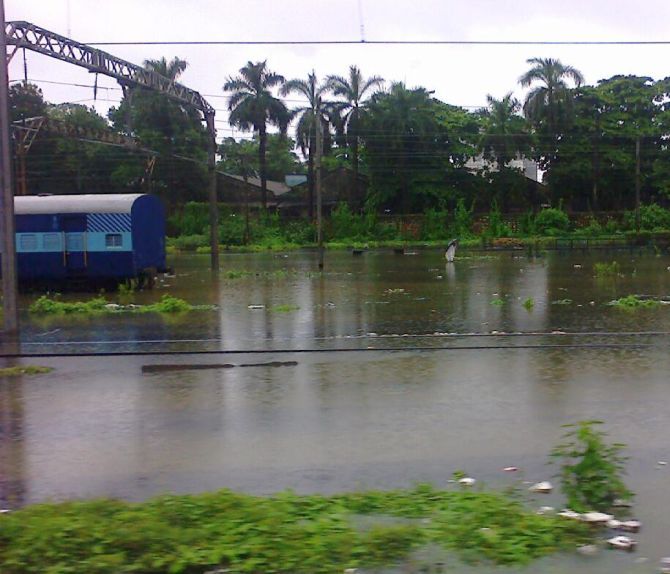Heavy rains pummelled Mumbai and its suburbs in which two persons died of electrocution and bringing normal life to a grinding halt on Friday with several areas waterlogged and local train services cancelled leaving thousands of commuters stranded.

As civic authorities described the rainfall in the country's financial capital as ‘unprecedented’, they said 283 mm of rain, which is normally received in 10 days, was witnessed in just 24 hours.

The Mithi River is around the danger mark, according to Yuva Sena Chief Aditya Thackeray. Educational institutions were shut and government and private offices reported thin attendance.

The Bombay high court and other courts were also shut.

"The city has witnessed unprecedented rainfall in the last 24 hours, more than that the city usually receives in 10 days. Mumbai witnessed 283 mm of rain in 24 hours," the city's Municipal Commissioner Ajoy Mehta told media persons.

“Of the total annual average rainfall Mumbai witnesses, 10 per cent of it has been received in 24 hours, which usually takes 10 days," he added.

There seems to be no let up in the situation with the Meteorological Department predicting heavy to very heavy rainfall in the next 24 hours.

According to an official of Brihanmumbai Municipal Corporation disaster management unit, a five-year-old boy and a 60-year-old woman died of electrocution in Wadala in central Mumbai.

The airport was operational but flight operations at the city airport were delayed by up to 45 minutes and three services had to be diverted due to incessant rain that has been lashing the financial capital since late Thursday evening.

There was also massive disruption of vehicular traffic with waist-high waterlogging being reported in several areas. The rainwater also entered several homes.

Mehta said Friday’s high tide witnessed in the city was of more than 3 metres high and Mumbai is likely to witness high tides of more than 4 metres, one at about 2 am and another at about 3:10 pm on Saturday.

"Since there is heavy rainfall along with a high tide expected on Saturday, people should stay away from the seas and ensure that they do not walk on the promenade. Also, before leaving their homes, people should make sure that the route they plan to take is safe for travel," he said.

The rains caused water-logging in almost all low-lying areas of Mumbai and its suburbs including Kurla, Chembur, Tilak Nagar, Andheri, Parel, Lower Parel, Thane, Navi Mumbai and Dombivili.

The heavy rains also forced the Shiv Sena to cancel its foundation day event.

Thousands of commuters leaving for offices were caught unaware on reaching the suburban railway stations as trains were being cancelled due to water-logging of tracks following heavy downpour since Thursday night.

Chief Minister Devendra Fadnavis appealed to people to venture out only if required and asked them to stay away from seafronts during high tide slots as it can prove ‘fatal’.

After taking stock of the situation at BMC disaster management cell, he also suggested to the public to refer to advisories being issued by the civic body on an hourly-basis before leaving home.

Narrating his ordeal, Nalasopara resident Atul Panday, an executive working with Alkem Laboratories said, "Normally, it takes me 50 minutes to reach Andheri from Nalasopara, but on Friday it took around two hours."

Hashtags like #mumbairains started trending on the micro-blogging website Twitter.
Those who did not tweet, updated their friends over WhatsApp, which has the ability to form closed-user groups. With "train-friend" being a very unique peculiarity for the city-dwellers, such messages of advice and caution soon started flooding dedicated groups of such friends.

Scenes of flooded tracks, overflowing platforms and railway indicators struggling were shared over applications like Facebook and Instagram by netizens.

However, the city lived up to its reputation for its warmth and camaraderie, with instant offers for car-pooling and help coming through social media as well as offline.
Pankaj Gupta tweeted offering a pick-up for anybody from Powai to Mahape in Navi Mumbai, where he was travelling. Similarly, Zubin Nallawala offered a lift to anyone travelling from Worli in central Mumbai to Fort.

Unlike the deluge of July 2006, which had seen telecom services shut down completely, the voice and data networks remained unaffected today, leading to a very active usage of such online media tools.

Social media engagement was not limited to individuals alone, and utilities like Central Railway also made best use of the medium to reach to the public.

The Central Railway twitter handle was among the most active ones, sending out updates on train movements and re-scheduling of long distance services.
The Mumbai Metro, which was among the few modes of transport which continued operations, also used Twitter to send out much needed messages.
As the day wore on, the same media were used artfully to send out humorous messages about the monsoon.
Photographs: Ashish Soni/Rediff.com











 © 2025
© 2025